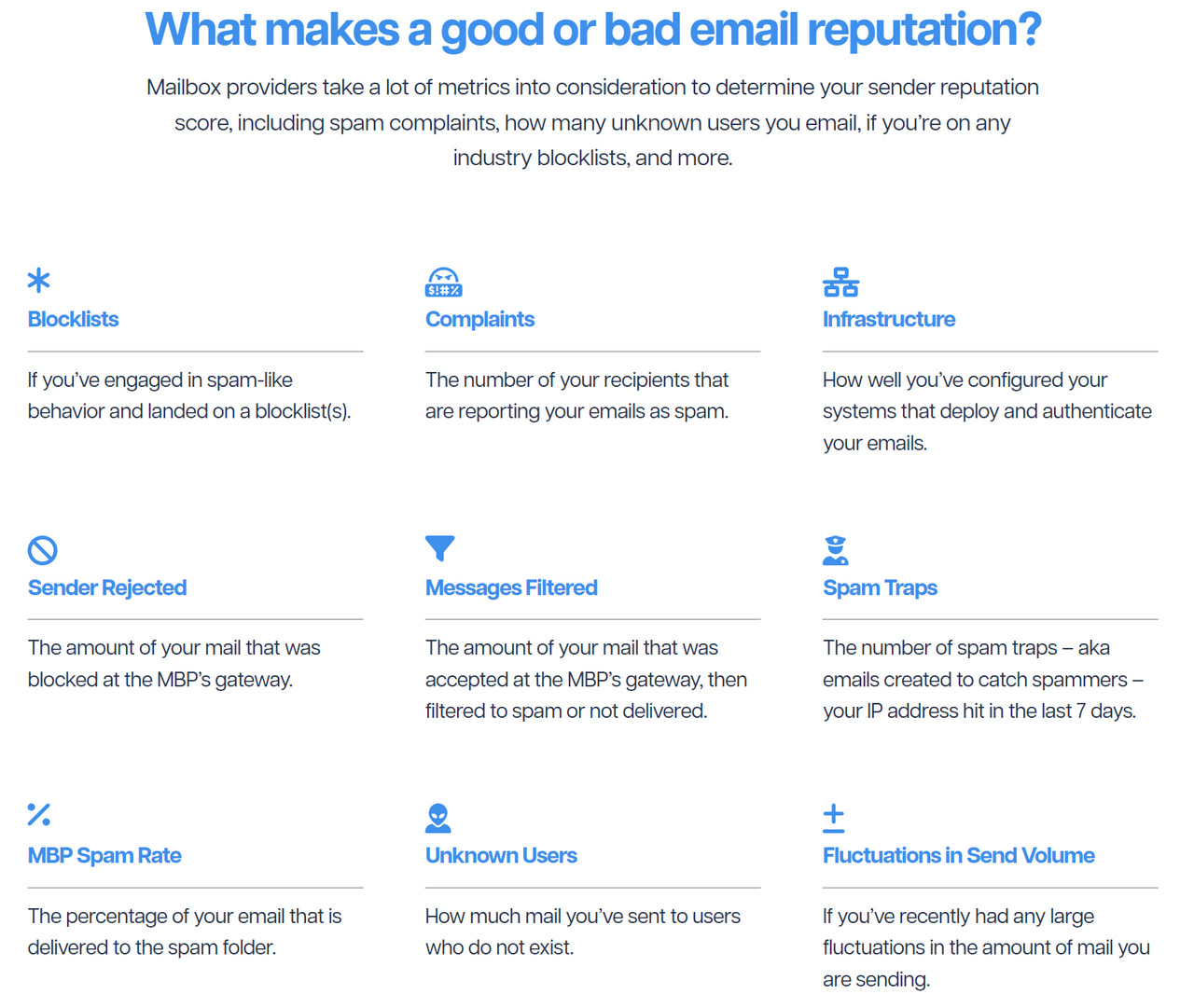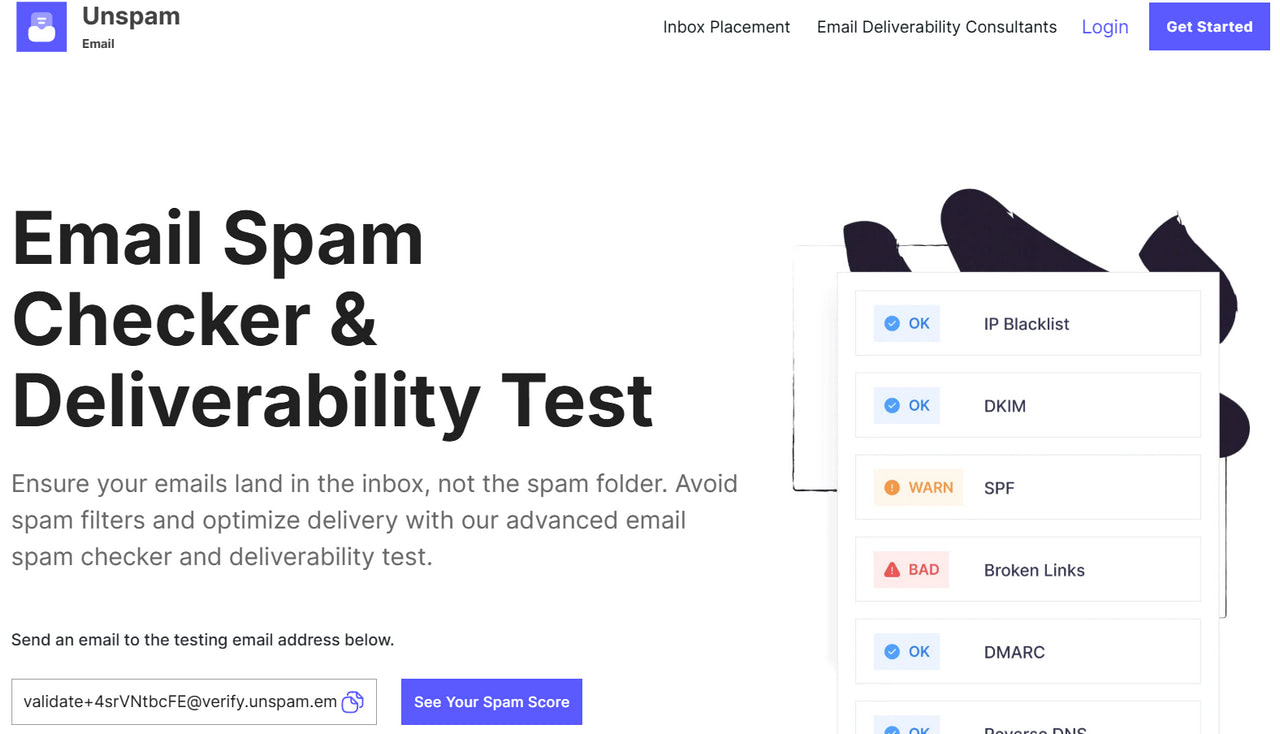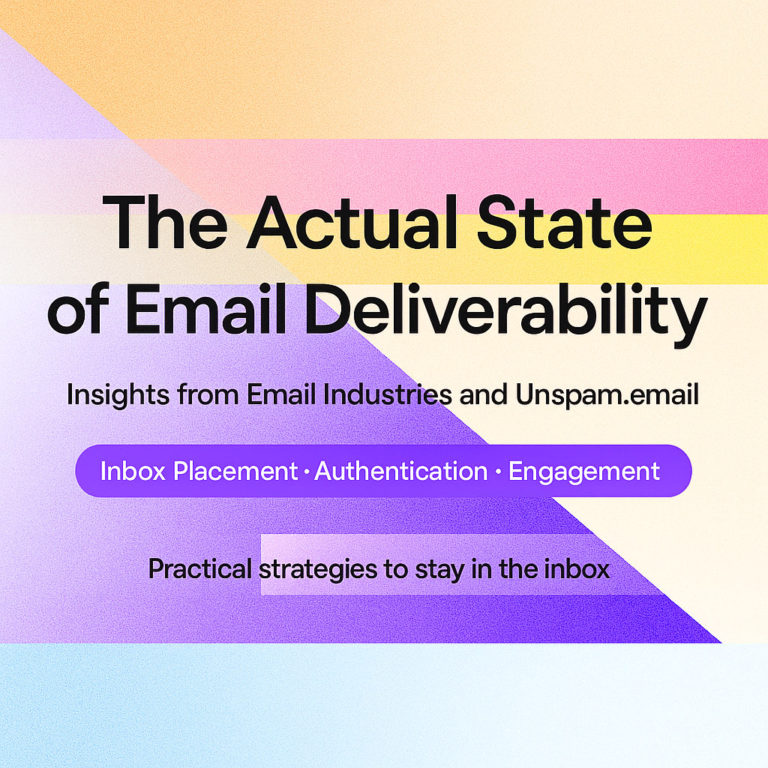Have you ever thought how bad the email sender reputation impact from spam emails could be? As a business owner who wants to grow and generate revenue, this could be a decisive factor in achieving marketing and branding goals. It might seem like a tiny detail, but it has one of the biggest effects on overall success.
Spamming, or in other words, sending unwanted and irrelevant newsletters for commercial intentions, never benefits the company despite the huge coverage or psychological tricks that might compel recipients to follow the lead. Ultimately, it ruins the sender’s reputation, devastating the company’s potential for direct outreach and negatively affecting many other critical aspects of its presence in the channel, including security, productivity, trust, competitive advantage, and customer relationships.
In this post, we will examine how bad email sender reputation impact from spam emails could be and what companies can do to minimize it by adopting actionable tips and professional recommendations.
How Bad Is Sender Reputation Impact from Spam Emails?
First things first: What is the sender’s reputation, and why is it important to monitor and maintain it as high as possible?
Sender reputation is what consumers, ISPs, and mailbox providers estimate about the company. This opinion is based on its activity, behavior, history, and credibility in the email channel. It is a quantitative measure determined by the sender’s score. The latter is a number between 0 and 100 assigned by ISPs and mailbox providers to brands based on certain aspects of their IP and domain reputation. Although it might differ among ISPs and mailboxes, yet as a rule, these fluctuations are insignificant.
A sender’s reputation is crucial to a company’s successful existence in the email channel. First and foremost, it influences the ability of a brand’s digital message to reach the inbox. If your sender score is low, mailbox providers will likely put a digital newsletter in the spam folder or reject it.
Second, it directly affects deliverability rate and email performance. Reaching subscribers’ inboxes is closely connected with crucial metrics such as deliverability, open rate, read rate, click-through rate, conversions, and ROI.
Third, it determines your credibility as a sender. If it is high, ISPs and mailboxes might be more tolerable to the company’s activity in the channel. This means if a company decides to increase sending volume (for example, during peak sale season), ESPs might positively react to that and let its digital newsletter in rather than blocking it.
Finally, it helps ISPs and mailboxes fight malicious actors. Sender score helps key participants of the email ecosystem to decide whether the company looks suspicious and requires anti-spam measures or not.
Many factors influence the sender’s reputation: recipient engagement, list acquisition, email campaign, domain and IP history, spam complaint, deliverability rate, and spam complaints, to name a few. They may have positive and negative impacts with the latter must be minimized to ensure the company’s growth.
When it comes to factors that deteriorate a sender’s reputation, nothing beats spam emails. Looking and behaving spammy ruins the sender’s score, nullifying the company’s efforts and restricting its activity completely. Here are several repercussions that demonstrate how badly is the sender reputation impact from spam emails.

What makes a good or bad sender reputation? (a visual snippet from Senderscore.org)
Damaged Relationships with Customers Through Increased Spam Complaints
Do you know that spam complaints are among the top reasons why mailbox providers reject a brand’s message in the first place and deteriorate the overall sender’s score and reputation? It is not just a registered report made by your recipients against emails they do not want in their inbox with which you need to deal, by the way. It is a crucial sign for Gmail, Yahoo, and others that something is wrong with the relationships between a company and its subscribers.
Mailbox providers do their best to protect their clients from malicious and unwanted correspondence, so they seriously consider this factor. While a couple of complaints are not harmful since mailbox providers understand that behavioral factors might be involved in this decision, so even legitimate senders get complaints from loyal subscribers time after time. Nevertheless, when this rate starts to grow, it becomes an alarming sign for them to inspect every correspondence from the company thoroughly.
When the spam complaint rate exceeds established industry benchmarks, it starts to damage email deliverability and sender reputation, impacting the effectiveness of marketing campaigns because ESPs put emails in a recipient’s spam folder by default.
As for companies, it means that the brand messages they send to their target audience are irrelevant or invaluable. The more spam complaints they get, the more likely digital newsletters will end up in the spam folder or be rejected. This leads to losing consistent and valuable connections and customer relationships.
To make matters worse, there are many reasons for spam complaints. It could be a pushy subject line, spammy email content, poor email design, failed email authentication, wrong cadency, bad IP reputation, absence of an unsubscribe link, or a human factor.
The best thing companies can do is to avoid looking like a spammer in their connection and address reports. It would also help to check every email in Unspam to locate possible faux pas that might cause subscribers to register a complaint.
No Compliance with Laws and Regulations
Another obvious negative consequence of sending unsolicited emails to your subscribers is an offense against the law. Engaging in spam activity, even unintentionally, can result in legal consequences (including hefty fines and even imprisonment) across multiple countries.
As a company that operates in the digital channel, you are obliged to obey laws to operate legally and ensure your connection is legitimate. Every country has regulations to protect consumers and businesses from misusing their data, ensuring a safe environment with their rights reserved.
For instance, the United States has the CAN-SPAM Act, Canada has CASL, and Europe has GDPR. These general acts cover all key moments concerning data privacy and protection, user rights, and company rules of conduct.
Demonstrating compliance with these regulations is critical for companies for many reasons. Besides avoiding fines that might cost a fortune, they enhance trust and credibility with recipients, leading to a positive perception of the sender and their emails. This could help increase the sender’s score and reputation across mailbox providers and ISPs.
Conversely, if a company’s activity in the channel resembles spammers, it results in legal consequences, including fines and legal action. Reports for non-compliance may lead to deliverability issues and, worst of all, blacklisting that might easily restrict the company’s activity in the channel simply because ISPs and mailbox providers reject messages coming from blocked senders.
Limited Brand Activity
Speaking of blocked senders, how bad the sender reputation impact from spam emails could be is also evident in blacklisting. An email blacklist, also known as Domain Name System-based Blackhole List, is a database of IP addresses and domains caught because of their malicious behavior in the email channel.
There are several types of blacklists: domain-based blacklists, IP-based blacklists, public blacklists available to the general crowd, private blacklists reserved for the use of major mailbox providers, and enterprise spam firewalls maintained by independent organizations. All ESPs have email blacklists that they share with others to create a safe email ecosystem.
Getting on the blacklist is ridiculously easy for companies that are negligent in their behavior in the channel. Spamming recipients with unwanted emails is one of the main reasons that raise red flags and make blacklist vendors place companies under their radar.
The implications of blacklisting are significant. First and foremost, it hinders the company’s ability to communicate with customers, clients, or users, as mailbox providers put emails into spam folders or reject them from blacklisted domains and IP addresses.
Second, it decreases email deliverability. With ESPs looking suspiciously at your correspondence, even legitimate and wanted emails may end up in the spam folder by default. This means overall deliverability and open rates will suffer.
Third, it ruins key email performance and causes wasted investments. As fewer emails reach your subscribers, the worse results you get with every outreach, leading to poor ROI.
Finally, it destroys the presence in the channel. While some blacklists have mediocre aftermath, others might restrict a company’s activity in the channel completely.
All these consequences directly affect the overall brand and the sender’s reputation. With restrictions and limitations in the channel, companies will not have a chance to prove their validity and necessity to subscribers, missing rare opportunities to meet their needs and deliver them value. Their connection with fans will become thin, ruining the company’s perception in the channel.
Ruined Brand Reputation by Looking Unethical, Illegal, and Untrustworthy
Spamming your subscribers and causing spam complaints leads to drastic outcomes for companies regardless of niche. From losing stable connections for direct outreach to facing hefty fines and legal consequences, their disobedience to the law may not only halt activity in the email channel but also lead to drastic outcomes across other marketing channels.
Sending unsolicited emails can make a company look illegitimate and ruin its presence in the digital world across directions and interaction points. First, with a broken connection in the email channel, companies waste golden opportunities to reinforce their marketing strategy, as direct outreach is one of the most important sources of engaged traffic for landing pages.
Second, they miss crucial insights about their customers’ current demands and expectations that email analytics provides with every interaction.
Third, they decrease a competitive advantage. As more companies understand the potential hidden in email channels, those left behind lose their ability to fight competitors.
Fourth, they waste money, as email marketing is one of the most cost-effective tools for generating leads and revenue.
However, all that is not a match for a tarnished brand reputation. When a company behaves unethically and illegally, looking suspicious and annoying, it devastates its trust and credibility. According to The World Economic Forum, these two qualities undermine a positive brand reputation, which directly relates to 25% of a company’s market value. It is essential for attracting new clients, retaining existing customers, building brand loyalty, and successfully existing in the market.
To sum up. How bad is the sender reputation impact from spam emails? The answer is – it is devastating. Companies might feel the consequences of spamming almost immediately when mailbox providers reject their precious emails due to high spam or spam complaint rates.
The good news is that there are time-proven ways to avoid this situation and save your presence in the email channel. Follow our recommendations for behaving legally in the channel and avoid spamming your subscribers.
How to Prevent Spamming Your Subscribers?
Behaving ethically, legally, and non-spammy in the email channel requires companies to introduce three main stages in their marketing routine: detection, reduction, and prevention. Let’s consider each one closely.
Detection: Check Your Email Content, Design, and Technical Side in Unspam
Detection is the first stage to introduce in your email marketing routine. It is important to analyze the company’s current activity (including overall strategy and campaigns) to spot faux pas that might cause outreach to look unsolicited not only in the eyes of ISPs and ESPs but also subscribers.
Many factors may turn a valuable email into spam. First, there could be an absence of proper authentication. Starting as an instrument to fight cyber-attacks like phishing and spoofing, now it is a widely acknowledged standard for security, credibility, and legitimacy.
It has become so important for protecting the email ecosystem that Gmail and Yahoo officially announced last year that they would reject emails without correct DMARC, SPF, and DKIM. In other words, if you do not send authenticated emails (this concerns every digital newsletter, including transactional ones,) you will look like a spammer for ESPs and ISPs today.
Second, it could be a poor subject line. You might ask, what does a single line of words have to do with spamming? You should know that according to GDPR and other regulations, phrases associated with deceptive or overly aggressive marketing tactics and pushy rhetoric are considered spam. This also concerns subject lines with capitalized letters, excessive punctuation (especially exclamation signs), emojis, and clickbait details.
Third, attachments and broken links may make an email look spammy, as many malicious attacks start with infected files attached to digital newsletters and links that lead to suspicious sources with automatically downloadable scripts. If something is wrong with your attachments or your links do not match destinations, mailbox providers may easily consider you spam.
Fourth, low sender score. As we have already pointed out, spam email badly affects the sender’s reputation, degrading and even nullifying it in the worst-case scenarios. A low sender score indicates that the company is untrustworthy and behaves suspiciously, so ISPs and mailbox providers will be skeptical about its correspondence.
Finally, email design and body copy. Malicious actors’ imaginations go wild here, so they invent numerous ways to trick readers into revealing their sensitive data, downloading viruses, or visiting links to dangerous destinations. Hackers use every critical detail of the newsletter to achieve their goals, from overpromised headlines to clickbait to a sense of urgency.
How do you spot all these mistakes? The best way is to employ professional instruments as they might quickly, efficiently, and cost-effectively inspect emails and analyze all key details, providing you with a thorough report filled with insights and inconsistencies. Consider Unspam – one of the niche’s most popular, reliable instruments.
Unspam’s main sphere of expertise is optimizing your delivery and ensuring your emails land in the inbox rather than spam by conducting comprehensive deliverability tests and email spam checks that include the following routines.
- It runs through popular blacklists to ensure your IP address, email address, and domain name are not listed.
- It conducts a full accessibility test.
- It checks the technical side, including the SPF record, DKIM key, DMARC record, Reverse DNS, domain suffix, domain age, and List-Unsubscribe Headers.
- It thoroughly inspects subject lines and email body copy and designs against the best practices for locating spam phrases, broken links, short URLs, poor text-to-image ratios, and other issues that might raise spam filters.
- It provides instant email previews across multiple devices.
- It generates an AI eye-tracking heatmap.
There is more. Having one of the best email experts on board, Unspam also offers company recommendations based on relevant insights obtained from inspection and analysis. Companies may speak with our email deliverability consultants to address their unique issues and refine strategies.

Unspam – email spam checker and deliverability test
Reduction: Fix Mistakes in the Technical Side, Subject Line, Email Body Copy, and Design
After locating your faux pas in email campaigns and newsletters through Unspam, the company should eliminate or at least minimize those inconsistencies and issues. So, the next step is the reduction of spammy-like activity. There are several areas to focus on.
The first one is to ensure you have a clean sheet from the blacklist vendors. Being caught by a blacklist is one of the worst scenarios that could happen to a company, as it may nullify its efforts and restrict its activity in the channel completely. Therefore, remove your IP address, email address, or domain from the Blackhole list. Check out our step-by-step guide to remove your email from the blacklist to get some actionable tips.
Second, fix your technical side. Proper authentication is essential to deliver your message to Gmail and Yahoo subscribers. Therefore, ensure SPF, DKIM, and DMARC are correctly configured for all your digital newsletters. Fix every issue, rotate keys, and check everything through professional instruments.
Third, eliminate the first signs of spammer activity from the newsletter. This includes attachments, broken links, short URLs, and impersonalized and capitalized subject lines.
Finally, improve email body copy and design. Remove spammy words, pushy phrases, and a sense of urgency from the content. Work towards better accessibility and fix inconsistencies in email display through various screen sizes.
Prevention: Obey the Laws and Follow the Best Practices
Adopting a proactive strategy in your email marketing routine is the best way to keep your sender’s score high and ensure the company’s success in the channel. It helps to avoid bad outcomes and anticipate possible issues that might cause emails to look spammy.
The prevention stage requires companies to inspect their email newsletters and campaigns in Unspam before sending them to recipients, fix issues, and follow the best recommendations. The latter includes the following:
- Never buy or rent subscription lists.
- Use double opt-in and get consent from every subscriber for every type of email.
- Provide an unsubscribe link and address the user’s request to remove their data from your database as quickly as possible.
- Clean mailing list regularly.
- Segment and hyper-personalize outreach.
- Send valuable and relevant brand messages to subscribers.
There are many more practices to adopt. However, first and foremost, companies must adopt those originated from the laws and regulations. As a rule, they are relevant and actional instructions for correct behavior in the channel that allow a company to operate legally and ethically and prevent it from bad scenarios in the first place.
Conclusion
The sender reputation impact from spam emails could devastate companies as nobody likes spamming, neither recipients nor ISPs, ESPs, and anti-spam organizations. The consequences of sending unsolicited or illegitimate emails to subscribers might be different: damaged customer relationships, undermined trust, ruined credibility, limited brand activity in the channel, and even hefty fines.
To make matters worse, even the best companies may resemble spammers, as ISPs and ESPs have very strict screening processes. However, there are ways to minimize spam-looking behaviors and ensure your outreach looks legitimate, maintaining your sender’s score and reputation high. This includes three basic stages: detection of faux-pas in Unspam, reduction of inconsistencies and errors, and adaptation of proactive strategies.





